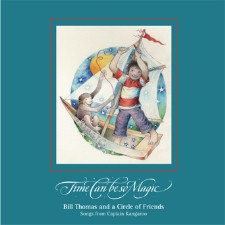I wrote an essay in my freshman college English class crediting the Captain Kangaroo TV show with fomenting the yearning, rebellious free spirit of the ‘60s generation.
Beginning in 1955, the Captain and his sidekicks---Mr. Green Jeans, Dancing Bear, Bunny Rabbit, Mister Moose and Grandfather Clock---were the opening act each morning for two or three generations of children, offering a gentle alternative to the frenetic silliness found in many of the programs aimed at youngsters for 29 years on CBS and six more on PBS.
Bill Thomas was just a little too old to be interested in the show when it first debuted, but he played a significant role in its later years. After a three-year Navy hitch stationed in Norfolk on the carrier Independence in the late ‘60s, the Rhode Island native decided to pursue a full-time music career.
“I had gotten out of the Navy,” he told me recently, “and I was living in New York trying to make it as a singer/songwriter. I was doing the score for a small, independent film, and that’s when I met this guy who was a scriptwriter for Captain Kangaroo. Noel Stookey [of Peter, Paul & Mary] was working on his first solo album in the same studio. I walked in and introduced myself, and Noel is so welcoming, he said, ‘Come on in.’ And that was the beginning of it.”
 The two struck up a friendship. Stookey, in fact, wrote the liner notes for Thomas’ new enhanced CD collection of songs and videos he produced for the Kangaroo show from 1974 to 1983, called Time Can Be So Magic.
The two struck up a friendship. Stookey, in fact, wrote the liner notes for Thomas’ new enhanced CD collection of songs and videos he produced for the Kangaroo show from 1974 to 1983, called Time Can Be So Magic.
“Several years after I met Noel,” Thomas remembered, “I had this idea for a children’s radio show. We called it The Sandman. I wrote a song called ‘The Sandman,’ took it to Noel, and we recorded several hours of material for a children’s radio pilot. I took it to my scriptwriter friend, hoping he could turn us on to somebody at CBS radio.
“They were looking at that time to bring in more contemporary songwriters for Captain Kangaroo, so they asked me if I would be interested in writing for them. And I jumped at it. We never did get to anybody at CBS radio!
“At the time, they had an arrangement with the Encyclopedia Britannica to have access to their library of films. The songwriters would come in and go through the stacks of film canisters, and see if there was anything in there. I had seen this film about logging in the northwest, and for some reason, embedded in it, there was this little kid going to the zoo in the rain. It was really a sweet piece of footage, so I came up with the idea of ‘Rainy Day Zoo.’
“After about two seasons of that, I asked if I could start doing my own footage. I hired a fellow I had met in Newport who was a budding film-maker---Denis Maloney, who’s now a successful director of photography working in Hollywood. He was a pilot boat skipper in the harbor by day, so he would work for me when he could. Over the years, I was leaning over his shoulder learning how to edit. I finally took over the editing as well, and he was my cameraman.”
I asked Thomas if he thought Captain Kangaroo would be too slow for the fast-paced, short attention span world in which today’s kids grow up.
“No,” he replied, “I think there’s always an audience for that kind of character. Fred Rogers is the most gentle of them all, and his shows are still airing. There’s a need for that balance, for a slower, more thoughtful pace at which children can digest and feel comfortable not having to keep up with what’s thrown at them. He’s so reassuring, and takes time to look directly into the camera to make sure that the kids are looking right into his eyes. Everybody’s had their time making fun of that show because it’s such an easy target, but it’s right on target too.”
Bill Thomas’ children’s songs are also right on target. From the happy, upbeat opener, “Good to See You Again,” through attractive ballads like “Rainy Day Zoo” and “Papa,” to the happy goofiness of “Eatin’ Sketti” and “Giggles,” this is timeless music that sounds as fresh and contemporary now as when it first aired over two decades ago. Yes, that’s Noel Paul Stookey singing “Tell Me a Story” and “Mother and I,” a young Cheryl Wheeler on “Circles,” and Dave Mallett’s distinctive Maine-grown voice on “Hard to Say Goodbye.” These are songs for kids of all ages and all generations.
Thomas has written plenty of “grownup songs” too, and he thinks that material aimed at young people should be just as strong musically.
“I don’t think it’s any different,” he said. “For me, most of the time I was remembering my own childhood, and writing about emotions and feelings I had. I’ve always loved great melody and good rhythms, so I just wanted to make sure that I liked the song. As long as I liked it, I was willing to present it.”
Time Can Be So Magic includes fourteen songs and three videos first aired on Captain Kangaroo, and is available online at www.timecanbesomagic.com.
copyright © 2005 Jim Newsom. All Rights Reserved.

